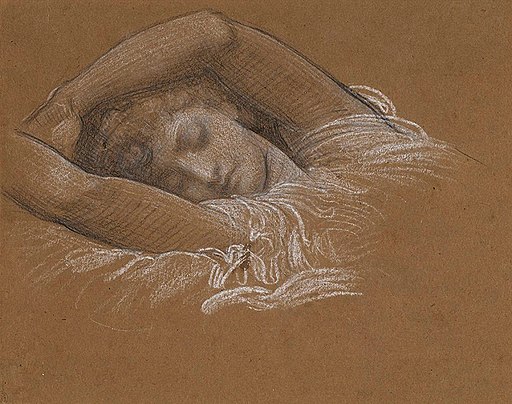
“Cymon and Iphigenia” by Frederic Leighton depicts a mythological story about “Cymon” which means “the brute,” who one day while walking in the woods, discovered a young woman, “Iphigenia,” fast asleep in a meadow under a tree, and her beauty awoke his soul.
This parable of grace soothing the savage beast inverts the myth of “Sleeping Beauty,” in which a man awakens a young woman to adulthood. In this mythological story, the woman inspires the male, brute.
“Iphigenia” is derived from Greek (iphios) “strong” and (genes) “born.” Her name means “strong-born” or “born to strength.” In Greek myth, Iphigenia was the daughter of King Agamemnon.
After King Agamemnon offended the goddess, Artemis, the only way to appease the goddess was to sacrifice Iphigenia. Just as Agamemnon was about to sacrifice his daughter, she was safely transported to the city of Taurus.
The story of “Cymon and Iphigenia” is from the “Decameron,” a collection of novellas by the 14th-century Italian author Giovanni Boccaccio (1313–1375).

The expressiveness of Iphigenia’s elaborate, swirling drapery was influenced by Frederic Leighton’s study of the drapery on the statues from The Parthenon Marbles.
The Marbles had an impact on many British artists of the time. Leighton’s love for the classical world is artfully presented in this masterpiece.

In the original story, Iphigenia was mostly naked. However, Leighton, who painted in the Victorian Era, chose to cloth Iphigenia in drapery that contoured her body to ensure that the viewer’s gaze locked onto her figure.
The drapery pays homage to Hellenistic sculpture and enhances her beauty and elegance. Leighton also explored the best way for her raised arms to be positioned to produce an alluring posture.

A study of Iphigenia, black and white chalks on brown wove paper from Leighton House Museum.
Leighton spent months searching for a model to match his imagined ideal of Iphigenia, for his intended portrayal in this painting. He found his model in a young actress, Dorothy Dene.
Dene possessed what Leighton felt was a classical Greek style of beauty. She had golden wavy hair, graceful arms, and legs, and she has featured in several later works by Leighton.
Including: “The Bath of Psyche,” “Clytie,” “Perseus and Andromeda,” “Solitude,” “The Return of Persephone,” and “The Vestal.”

Self-portrait – Lord Frederick Leighton (note “The Parthenon Marbles” in the background)
Frederic Leighton
Sir Frederic Leighton (1830 – 1896) was an English painter and sculptor. His works depicted historical, biblical, and classical subjects.
He was successful and famous during his lifetime and was the bearer of the shortest-lived peerage in history, 1st Baron Leighton.
After only one day, his hereditary nobility became extinct upon his death. Leighton remained a bachelor with no legitimate children.
Leighton’s house in Holland Park, London, has been turned into a museum, the Leighton House Museum.
It has many of his drawings and paintings, as well as some of his former art collection.
Cymon and Iphigenia
- Title: Cymon and Iphigenia
- Artist: Frederic Leighton
- Created: 1884
- Period: Academic art
- Media: Oil paint on Canvas
- Dimensions: 163 cm × 328 cm (64 in × 129 in)
- Museum: Art Gallery of New South Wales, Sydney, Australia
Frederic Leighton
- Name: Frederic Leighton, 1st Baron Leighton
- Born: 3 December 1830 – Scarborough, England, United Kingdom
- Died: 25 January 1896 (aged 65) – London, England
- Known for: Painting and sculpture
- Movement: Academicism, Neoclassicism, and British Aestheticism
- Notable Works:
- Cimabue’s Celebrated Madonna is carried in Procession through the streets of Florence
- Cymon and Iphigenia
- Perseus and Andromeda
- Icarus and Daedalus
- Perseus On Pegasus Hastening To the Rescue of Andromeda
- Desdemona
- Flaming June
The Story Of Iphigenia – Greek Mythology Explained
A Tour of the Art Gallery of New South Wales
- “The Visit of the Queen of Sheba to King Solomon” by Edward Poynter
- “Vive L’Empereur” by Edouard Detaille
- “Bailed Up” by Tom Roberts
- “Cymon and Iphigenia” by Lord Frederic Leighton
- “Summer Time” by Rupert Bunny
- Diogenes by John William Waterhouse
Art Appreciation
Iphigenia
Mythological Paintings
- “The Birth of Venus” by Sandro Botticelli
- “Venus at her Mirror” by Diego Velázquez
- “Diana and Actaeon” by Titian
- “Aurora abducting Cephalus” by Peter Paul Rubens
- Landscape with the Fall of Icarus – Pieter Bruegel
- The Triumph of Bacchus
- “Dido Building Carthage” by J. M. W. Turner
- “Venus and Mars” by Sandro Botticelli
- “Primavera” by Sandro Botticelli
- “The Birth of Venus” by Sandro Botticelli
- “Bacchus and Ariadne” by Titian
- “The Rape of Europa” by Titian
- “Perseus and Andromeda” by Titian
- “Perseus and Andromeda” by Joachim Wtewael
- “Perseus and Andromeda” by Giuseppe Cesari
- “Perseus and Andromeda” by Frederic Leighton
- “Perseus with the Head of Medusa” by Antonio Canova
- Cymon and Iphigenia by Frederic Leighton
- “Aurora and Cephalus” by François Boucher
- The Lady of Shalott by John William Waterhouse
- “Lady Lilith” by Dante Gabriel Rossetti
- Circe Invidiosa by John William Waterhouse
- “Hylas and the Nymphs” by John William Waterhouse
- “Pygmalion and Galatea” by Jean-Léon Gérôme
- The Judgment of Paris (Prado Museum)
- The Judgement of Paris (The National Gallery, London)
Night mysteries – Iphigenia’s Dream
Franz Limmer – Piano Quintet in D-minor, Op.13 (1834)
~~~
“Nights through dreams tell the myths forgotten by the day.”
– C.G. Jung
~~~
Photo Credit:1) Art Gallery of New South Wales [Public domain] 2) By Frederic Leighton (Leighton House Museum) [Public domain], via Wikimedia Commons 3) Frederic Leighton [Public domain], via Wikimedia Commons 4) GM 5) © Marie-Lan Nguyen / Wikimedia Commons, via Wikimedia Commons
Popular this Week








 Sponsor your Favorite Page
Sponsor your Favorite Page SEARCH Search for: Search Follow UsJoin – The JOM Membership Program
Sponsor a Masterpiece with YOUR NAME CHOICE for $5
Share this:
- Tweet
